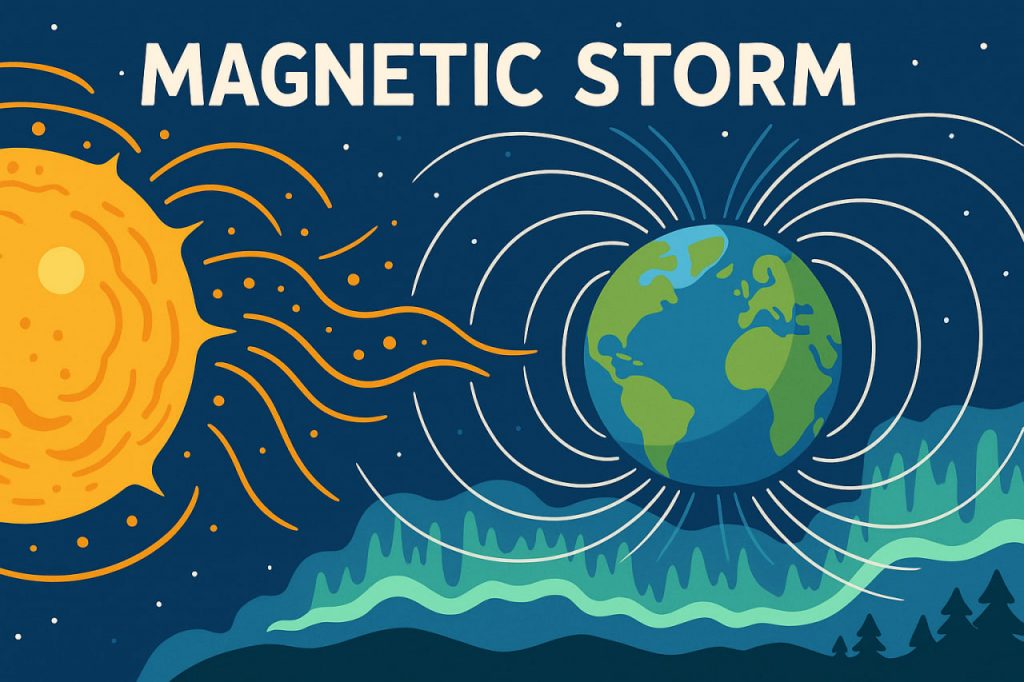Geomagnetic storms, often called magnetic storms, are large-scale disturbances in Earth’s magnetic field caused by solar activity. These powerful natural events can affect not only the planet’s magnetosphere but also technology, health, and weather-like conditions in space. While we cannot see or hear geomagnetic storms, their impact can be both spectacular and disruptive.
The Cause of Geomagnetic Storms
Geomagnetic storms are triggered by solar events, such as:
- Coronal Mass Ejections (CMEs): Massive bursts of solar plasma and magnetic fields released into space.
- Solar Flares: Explosions on the Sun that emit high-energy radiation.
- High-Speed Solar Wind Streams: Particles emitted by the Sun, especially from coronal holes.
When these particles and magnetic fields reach Earth, they interact with the planet’s magnetosphere, causing it to become compressed, disturbed, or reconfigured. The most intense reactions happen when the solar magnetic field is directed opposite to Earth’s field, allowing energy to flow into the magnetosphere.
Effects on Technology and Infrastructure
Geomagnetic storms can disrupt a wide range of technological systems:
- Satellites and GPS: Navigation errors and damage to sensitive electronics.
- Radio Communications: Disruption of high-frequency (HF) radio signals, especially in polar regions.
- Power Grids: Surges in electric currents can damage transformers and even cause large-scale blackouts.
- Pipelines: Induced currents can lead to faster corrosion of metal pipelines.
Engineers and space agencies monitor space weather constantly to protect vital infrastructure from potential damage during geomagnetic events.
Impact on Human Health
For most people, geomagnetic storms do not pose direct health risks. However, some studies suggest possible effects on:
- Cardiovascular health: Small increases in heart attacks and blood pressure in sensitive individuals.
- Sleep cycles and mood: Disruptions to melatonin levels and circadian rhythms.
- Astronauts: Increased radiation exposure outside Earth’s atmosphere during strong storms.
The influence on human health is still being researched, and while the general population is safe, people with heart or neurological conditions may be more sensitive.
Natural Phenomena: Auroras
One of the most beautiful effects of geomagnetic storms is the aurora borealis (northern lights) and aurora australis (southern lights). These occur when charged solar particles collide with gases in Earth’s atmosphere, producing glowing curtains of light in the sky, typically seen near the polar regions. During strong storms, auroras can be visible much farther from the poles.
Monitoring and Forecasting Magnetic Storms
Space weather agencies like NOAA and NASA use satellites to monitor solar activity in real time. The Kp index is commonly used to rate geomagnetic storm intensity, ranging from 0 (calm) to 9 (severe storm). Public alerts are issued when a strong geomagnetic storm is expected, allowing companies and governments to take preventive measures.
Glossary
- Magnetosphere — The magnetic field around Earth that protects it from solar particles.
- Solar Wind — Stream of charged particles from the Sun.
- Coronal Mass Ejection (CME) — A massive burst of plasma and magnetic field from the Sun’s corona.
- Aurora — A natural light display caused by solar particles interacting with Earth’s atmosphere.
- Kp Index — A global measure of geomagnetic storm intensity.


